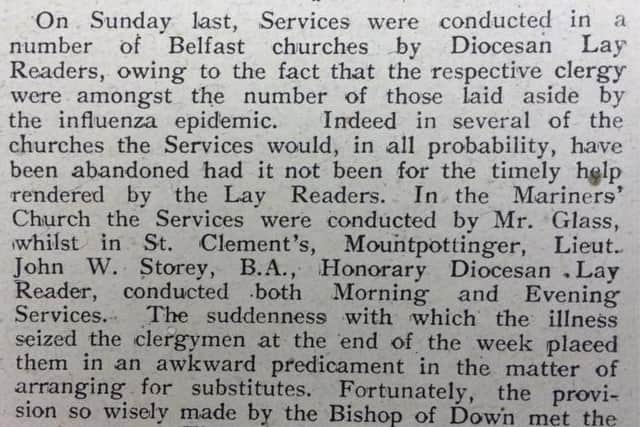Intriguing accounts of 1918-1919 ‘flu pandemic in church archives
This article contains affiliate links. We may earn a small commission on items purchased through this article, but that does not affect our editorial judgement.


The monthly Church of Ireland Gazette, reflecting the news and views of the church north and south, was first published in March 1856 and originally called the Irish Ecclesiastical Gazette.
It has been editorially independent of the church since it started, when it was sub-captioned the ‘Monthly Repertory of Miscellaneous Church News’.
Advertisement
Hide AdAdvertisement
Hide AdIt changed from monthly to weekly in 1880, and was renamed The Church of Ireland Gazette in 1900. Monthly again since January 2019, there’s a full archive of back copies in the Representative Church Body (RCB) Library in Dublin.


The RCB Library, which is the Church’s central repository for archives, has been working with the Gazette since 2013 to digitise its archive material and make it available to the public online.
This is an awesome resource which anyone can browse (full website details at the end of today’s page) and whilst Roamer has spent many hours perusing all sorts of intriguing articles from and about days of yore, a particularly pertinent story was published in the Gazette in July.
The RCB Library commissioned historian and writer Dr Ida Milne to compile a timely analysis of the 1918-1919 influenza pandemic, as seen by the Gazette at the time.
Advertisement
Hide AdAdvertisement
Hide AdBut before looking at that, some church news from Galway. It has been happening all week, and ends on Sunday - St Nicholas’ Collegiate Church in Galway is currently celebrating the 700th year since its foundation by ringing its church bells for seven minutes at 7pm for seven days!


All the sevens!
The initiative started last Sunday so there are a couple more evenings of ringing, which you can see and hear online.
The bells have been bringing welcome hope and solace, pealing at 12 noon every Friday during the pandemic and lockdown for frontline workers and for all those navigating through isolating, lonely or difficult times.
There has been an overwhelming public response as the sound of the bells assures people that they are not alone.
Advertisement
Hide AdAdvertisement
Hide Ad

The livestreaming of the bell-ringing is on www.facebook.com/stnicholasgalway where the public can also donate to keep the bells ringing for another 700 years!
And now to Dr Milne’s article about the 1918-1919 pandemic in Ireland through the lens of the Church of Ireland Gazette.
Dr Milne has been referenced on Roamer’s page more than occasionally in the past.
She is an expert on the impact of infectious diseases on Irish society over the course of the 20th century and her book Stacking the Coffins, Influenza, war and revolution in Ireland 1918-1919 (Manchester, Manchester University Press, 2018) is widely acclaimed, as is her recently co-edited (with Dr Ian d’Alton) collection of essays exploring identity, Protestant and Irish: The minority’s search for place in independent Ireland (Cork University Press, Cork, 2019).
Advertisement
Hide AdAdvertisement
Hide Ad

She has been in great demand in recent months as a commentator on the parallels and contrasts between the current Covid-19 pandemic situation and what Ireland experienced during the 15-month period between the spring of 1918 and early summer of 1919 in the flu pandemic widely known as the ‘Spanish flu’, another unusually deadly pandemic caused by the H1N1 virus.
In her July archive article Dr Milne explored how the influenza pandemic was reported just over 100 years ago by the Church of Ireland Gazette.
She noted that in the early summer of 1918 the editorials of the Gazette appeared far more concerned with matters political and military than religious.
“The hot debate in the June 28, 1918 edition, for example, was a speech during the week by Viceroy Sir John French, where he made it clear that while Lloyd George was abandoning Home Rule, conscription would press ahead if there were not 50,000 recruits to the hard-pressed army by October. The leader writer tied his colours to the mast by commenting that ‘we are not - we imagine after his recent gyrations on Irish policy few Irishmen are - among the whole hearted admirers of Mr Lloyd George’.
Advertisement
Hide AdAdvertisement
Hide Ad“In the background, behind the machinations of politics and the lumbering war, a darker force was beginning to emerge: the most extensive influenza pandemic in the modern world.”
In the early summer of 1918 the reality of the pandemic began to dawn and from the Gazette of June 28 Dr Milne noted that “the wisdom of having laymen on standby to take services was commented upon, given the ‘suddenness with which the illness’ could seize clergymen, placing them in ‘an awkward predicament’.
Influenza threatened the life of the Primate of All Ireland, Archbishop John Crozier, “mentioned in passing” Dr Milne observed “when he is absent from a diocesan meeting.”
On July 12, 1918, a columnist made the stark observation ‘Belfast has paid a heavy toll in the recent influenza epidemic. In the Registrar General’s return for the seven days ending 19th ult. no less than 341 deaths are recorded. In other words, the death-rate reached the abnormal rate of 45.2 per 1,000 per annum…’.
Advertisement
Hide AdAdvertisement
Hide AdDr Milne’s full article can be read at www.ireland.anglican.org/library/archive. The Gazette’s website is http://www.gazette.ireland.anglican.org, the archive can be searched at https://esearch.informa.ie/rcb and a guide to help readers when using the search engine can be found at https://bit.ly/3n3na8i